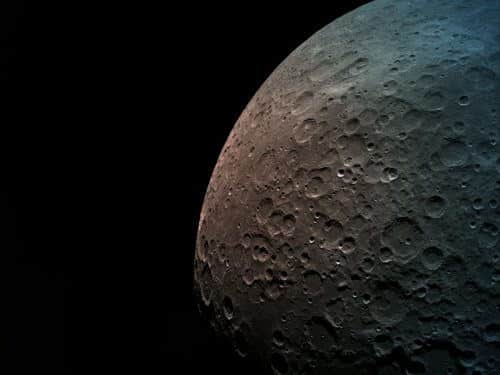In the meantime, the Bereshit spacecraft continued to transmit images it had taken over the weekend, before the maneuver
Update, Monday, 8.4
This morning, Monday 8.4.19/07/48 at 36:6 a.m., members of the SpaceIL and Aerospace Industry engineering team performed another maneuver around the moon. During the maneuver, the engines operated for about XNUMX seconds and the amount of fuel burned was about XNUMX kg.
In the maneuver, the altitude of the Apollona (the farthest point from the Moon) was lowered from an altitude of 750 km to 200 km from the Moon and actually became the Perilone (the closest point in front of the Moon). The spacecraft is now in an elliptical orbit at an altitude of 211 to 467 km from the surface of the moon.

A successful first maneuver of the Bereshit spacecraft around the moon reduced the height of its orbit
Update - Sunday, April 7.4.2019, XNUMX
This morning, Sunday 7.4.19/04/36 at 271:55 a.m., the first successful maneuver around the Genesis moon was performed by the SpaceIL engineering team and the aerospace industry. During the maneuver, the engines operated for about XNUMX seconds and the amount of fuel burned was about XNUMX kg. In this maneuver, all the spacecraft's engines worked simultaneously to brake the spacecraft with the highest power so far (the spacecraft's maximum thrust).
In the maneuver, the height of Apollo (the farthest point from the moon) was lowered from an altitude of 10,400 km to about 750 km from the moon. The perilone (the closest point in front of the moon) remains about 460 km from the moon's face.
Over the weekend, Bereshit took additional pictures of the far side of the moon - credit to Bereshit photography courtesy of SpaceIL and the Aerospace Industry.
The first one was taken above the parilona on April 5.4 at 8:00 (Israel time) at an altitude of 550 km. And the second was taken on the same day at 9:50 (Israel time) at a distance of 2500 km above the surface of the moon.


3 תגובות
Conan take worry out of your heart, I'm sure the spaceship is not lost/crashed and nothing is being hidden from us (except the alien bases which are clearly visible in the unreleased photos).
I assume it has to do with the width of a narrow film that allows information to be transmitted only at low rates, and also that which can probably only be transmitted when the State of Israel and the spacecraft are in direct line of sight.
Why aren't the photos taken by "Bereshit" published in the various media at all? There are maybe 3-4 photos starting from the moment of launch until now... even in the article here two identical photos appear, when this photo was actually taken back on April 5.4.2019, 3 - XNUMX days ago, right after the moon capture maneuver!
Is there a problem with the spacecraft? Can the controllers on Earth even communicate (not to mention control) the movement of "Bereshit"? Is there room for conspiracy theories, according to which the spacecraft crashed/disappeared/no communication/classified photos and top secret information that cannot be published/etc.?
What is the resolution of the image? How much is each pixel worth?
Does the spacecraft happen to pass over one of the landing sites of the Apollo spacecraft? Is there a chance that she will be able to photograph one of the landings there? On Wednesday, Berashit's orbit is supposed to be really low (15 km above the ground if I remember correctly) and if it manages to photograph one of the Apollo spacecraft it will be really amazing... just throwing out an idea.